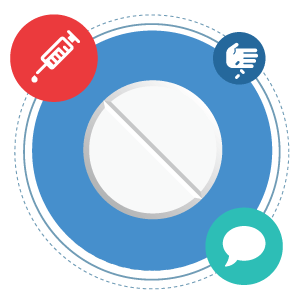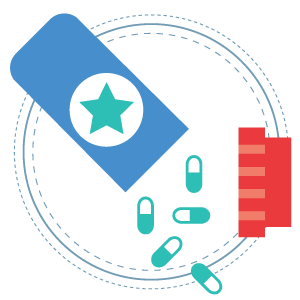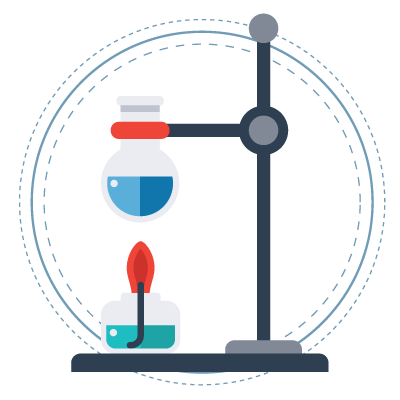Drugs & Biologics
Whether they come in the form of a pill, injection or intravenous infusion, drugs and biologics are meant to better patients’ quality of life by keeping them healthy. While these medicines provide a benefit for many patients, they are not safe for everyone. It’s critical consumers know the risks associated with these medicines, so that they can make informed decisions about their health care.
Editors carefully fact-check all Drugwatch.com content for accuracy and quality.
Drugwatch.com has a stringent fact-checking process. It starts with our strict sourcing guidelines.
We only gather information from credible sources. This includes peer-reviewed medical journals, reputable media outlets, government reports, court records and interviews with qualified experts.
A drug is a recognized substance that causes changes in the body and is used on its own or as a component of a medicine to diagnose, treat or prevent a condition. The term “drug” includes biological products, or biologics. Biologics are generally covered by the same laws and regulations as other drugs, but differ in the way they’re manufactured.
The U.S. Food & Drug Administration (FDA) must approve every drug or biologic before it can be used by the public. In 2015 alone, the FDA approved 51 new drugs and biologics. The agency’s Center for Drug Evaluation and Research (CDER) approved 45 drugs, and the Center for Biologics Evaluation and Research approved six therapies.
However, FDA approval does not guarantee safety. Each drug and biologic has the potential to cause life-altering and even life-threatening side effects. Sadly, too many people suffer severe side effects — and some have died — because drug manufacturers fail to adequately warn of the risks associated with the medicines they market.

Drugs
Traditional, synthetic drugs, such as Xarelto and Crestor, are manufactured from man-made components through a chemical process in a lab. Even within the traditional “drug” category, these medicines are approved, sold and regulated differently. Some are prescription drugs; others are known as over-the-counter drugs. Some are sold under a brand name; others are sold as generics.
- Recognized by an official pharmacopoeia or formulary
- Intended for use in the diagnosis, cure, mitigation, treatment or prevention of disease
- Intended to affect the structure or any function of the body (other than food)
- Intended for use as a component of a medicine but not a device or a component, part or accessory of a device
Prescription v. Over-the-Counter
Prescription drugs require a doctor’s authorization (a prescription). Doctors prescribe these drugs to be used by one person, and patients buy prescription drugs through a pharmacy. Examples of prescription drugs include Lipitor and Viagra.

In order for a prescription drug to be sold legally in the U.S., its manufacturer must formally ask the FDA to consider approving the drug. This is done by submitting a New Drug Application (NDA). The NDA includes animal and human data and analyses of the data. It also provides information about how the drug works in the body and how it is manufactured.
Over-the-counter, or OTC, drugs do not require authorization from a doctor. Consumers can buy them right off stores’ shelves without a prescription. Today, there are more than 700 products sold over the counter that use ingredients or dosage strengths that were available only by prescription 30 years ago. Examples of OTC drugs include Tylenol and Nexium 24HR.
The FDA decides whether an OTC drug can be sold by comparing it to OTC drug monographs, which specify acceptable ingredients, doses, formulations and labeling. OTC drugs that conform to an existing monograph can be sold without further FDA clearance. OTC drugs that do not fit an existing monograph must undergo the same review and approval as prescription drugs.
An OTC drug can have different approved uses and instructions than a prescription drug with the same name, so it’s important to follow the directions on the label and as given by your doctor.
“Next to the medicine itself, label comprehension is the most important part of self-care with OTC medicines”

Brand Name v. Generic
A brand name drug is a drug sold under a proprietary, trademark-protected name. In the case of a brand name drug, a pharmaceutical company discovers a new drug and files for a patent to prevent other companies from copying the drug and selling it. The drug has two names: a generic name, or a common, scientific name; and a brand name. This is the case for both prescription and OTC drugs.
A generic drug has the same active ingredients (the chemical substance that makes the drug work) as the brand name drug it’s copying and can be sold only after the patent expires on the brand name drug. The same manufacturer who makes the brand name drug can also sell a generic version, or a different company may make one.
In addition to having the same active ingredients, a generic drug must have the same amount of the active ingredients (dosage strength). It must also be available in the same form (pill, liquid, etc.) as the brand name drug, be introduced into the body in the same way and deliver the same amount of drug into the bloodstream in about the same time as the brand name drug.
Brand name drugs and their generic versions are sold under different names and can vary in their size, shape, colors and markings. They may have different inactive ingredients, and generics generally cost less than their brand-name counterparts.
“A generic drug is the same as a brand name drug in dosage, safety, strength, how it is taken, quality, performance and intended use, Before approving a generic drug product, FDA requires many rigorous tests and procedures to assure that the generic drug can be substituted for the brand name drug.”
Are All Drugs Dangerous?
Regardless of whether a drug is prescription or OTC, brand-name or generic, it has the potential to cause side effects.
“Side effects, also known as adverse events, are unwanted or unexpected events or reactions to a drug,”- according to the FDA.
Side effects of a drug can be as minor as headaches or as severe as increased risk of kidney failure. Sometimes side effects are associated with all drugs in a particular drug class.
Type 2 diabetes drugs
Invokana, Invokamet and Farxiga are all SGLT2 inhibitors. Drugs in this class are associated with diabetic ketoacidosis (DKA), kidney injury, blood infection, urinary tract infections and lactic acidosis.
Antidepressants
Prozac, Zoloft, Paxil, Celexa and Lexapro are all selective serotonin reuptake inhibitors (SSRIs), which are linked to increased thoughts of suicidal behavior and birth defects.
Stomach-acid drugs
Prilosec and Nexium carry warnings for kidney injury and bone fractures, as do other members of the proton pump inhibitor (PPI) drug class.
Fluoroquinolone antibiotics
Fluoroquinolones feature black box warnings — the FDA’s strongest warnings— for “disabling and potentially irreversible serious adverse reactions” such as tendinitis and tendon rupture; peripheral neuropathy and central nervous system effects. Drugs in this class include Cipro, Avelox and Levaquin and are reserved for use in patients who have certain conditions that cannot be cured with other medications.
Patients should not stop taking a prescribed medication without consulting a doctor.

Biological Products (Biologics)
Biologics are a made from natural sources, such as human or animal proteins. They are not made from synthetic compounds like other drugs. Biologics are intended to prevent or diagnose diseases, and to treat diseases and medical conditions.
Biologic medicines suppress the immune system and reduce inflammation. They are used in patients with complex diseases, including cancer and autoimmune disorders such as rheumatoid arthritis and Crohn’s disease. To be considered for biologics, most patients must have tried conventional medications and found their diseases stayed the same or got worse.
Some biologics like Humira can be self-injected; others like Remicade must be administered intravenously by a medical professional.
Although biologics can be very effective, they are also very expensive — some cost more than $45,000 a year. Unfortunately for the patients who depend on biologics, there are little to no alternatives that work as well. One 2022 research report noted the effect of rising prescription drug costs on seniors in the United States. The authors found that high prices can lead to non-compliance and non-adherence.
- Vaccines
- Blood and blood components
- Allergenics
- Somatic cells
- Gene therapy
- Tissues
- Recombinant therapeutic proteins
Biosimilars v. Interchangeable Biological Products
Biologics are made from living organisms, and so it can be impossible to pinpoint the components of a complex biologic. As a result, there are no generic versions of biologics. Instead, there are biosimilars and interchangeable biological products.
A biosimilar is a new type of biological product that is approved by the FDA because it is highly similar to an already FDA-approved biological product, known as a reference product. Biosimilars have some allowable differences because of how they are made; however, manufacturers of biosimilars must prove the products have no “clinically meaningful differences” from the reference products.

A biosimilar is only approved for the uses that were previously approved for the reference product. It must have the same mechanism of action, route of administration, dosage form and strength as the reference product. For a patient to receive a biosimilar a doctor must write the specific name of the product on the prescription. A pharmacist cannot give a patient a biosimilar in place of a reference product without a doctor’s prescribing it.
An interchangeable biological product not only meets the biosimilarity standard, but also it is “expected to produce the same clinical result as the reference product in any given patient,” according to the FDA.
A pharmacist may substitute a reference product with an interchangeable biological product without approval from the prescribing physician. In other words, a patient may receive an interchangeable biological product even if a doctor prescribes the reference product.
“And for a product that is given to a patient more than once, the risk in terms of safety and effectiveness of alternating or switching between the interchangeable and the reference product is not greater than the risk of using the reference product without alternating or switching,” according to the FDA.
Side Effects Associated with Biologics
Biologics may cause serious side effects. A serious side effect is defined as a life threatening adverse event that can result in death or hospitalization and disability or permanent damage.
A study published by Cochran Library in 2016 examined nine popular biologics and found that among people who took any biologic, 127 out of 1,000 had serious side effects compared with 118 people out of 1,000 who took placebo.
For many people, the first side effect they hear about with biologics is infection. While the medication itself may not cause the infection, it could prevent the body from fighting one. That’s because biologics alter the immune system and can compromise a person’s natural ability to fend off infection.
According to the Cochran Library study, people using biologics in the short term (one to 63 months) are more likely to experience serious infections or tuberculosis than people who take a placebo.
- 35 people out of 1,000 experienced serious infections compared with 26 people out of 1,000 who took placebo
- 20 out of 10,000 had tuberculosis compared with 4 people out of 10,000 who took the placebo
Severe allergic reaction is another potentially fatal side effect of biologics. These reactions may look different depending on how a patient receives the drug. A patient who receives a biologic through a needle in the vein may have an allergic reaction that causes shortness of breath, chills, and/or itchy eyes and lips. Those who inject their biologics may experience a reaction, such as a rash, at the site where the skin was punctured.
It’s important for patients to talk with their doctors about the risks associated with biologics before starting treatment. Patients should alert their doctor of any changes they experience during or following treatment with a biologic.
- Severe and even fatal infections
- Worsening or new heart failure
- Tuberculosis or hepatitis B reactivation
- Allergic reactions
- Central nervous system symptoms
- Lupus-like syndrome
- Cancer
What to Do if You’ve Been Harmed
To many people, a drug is meant to bring relief and a biologic is the last hope for getting their lives back. So it’s even more devastating when the medicine intended to relieve their symptoms or prevent illness ends up leaving them with a debilitating condition.
Although it may not resolve medical issues, there are actions injured patients can take to help lessen the distress and help protect others from the same problems, including reporting side effects to the FDA and seeking compensation and justice through a lawsuit.
Lawsuits
A combined 97,805 personal injury/product liability cases were filed in U.S. district courts in 2014 and 2015. Drug-injury lawsuits may go after a company over marketing defects, design defects or manufacturing defects. Marketing defects, also known as failure-to-warn defects, are some of the most common types of product liability lawsuits.
Report to the FDA
The FDA encourages consumers to report adverse events to the agency. It evaluates each report to determine the level of seriousness and may ask for more information from the person who filed the report before taking action.
“The testing that helps to establish the safety of products, such as drugs and medical devices, is typically conducted on small groups before FDA approves the products for sale, Some problems can remain unknown, only to be discovered when a product is used by a large number of people.”
Calling this number connects you with a Drugwatch.com representative. We will direct you to one of our trusted legal partners for a free case review.
Drugwatch.com's trusted legal partners support the organization's mission to keep people safe from dangerous drugs and medical devices. For more information, visit our partners page.


